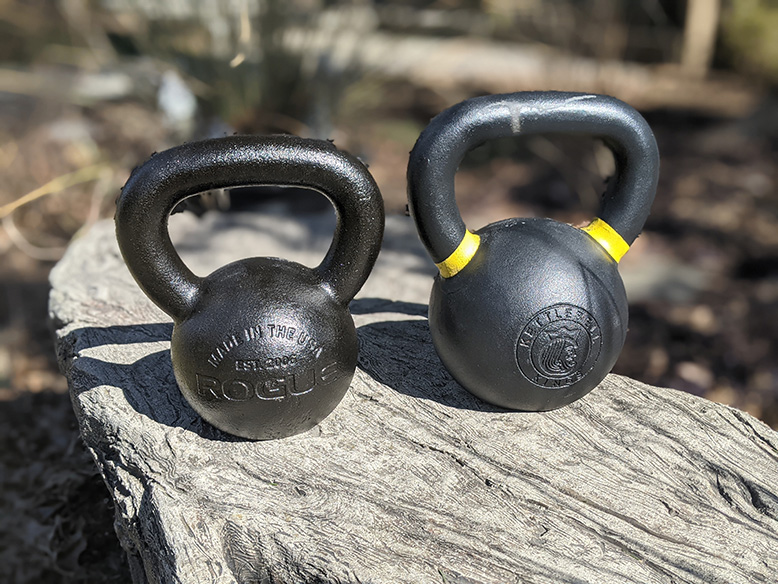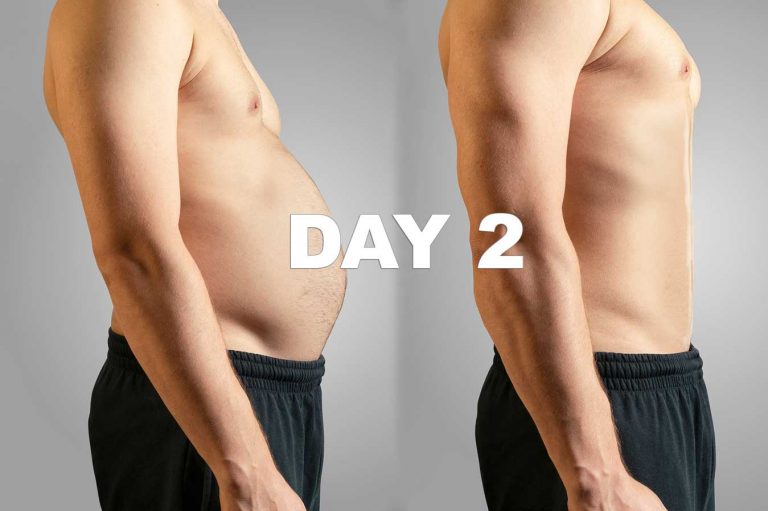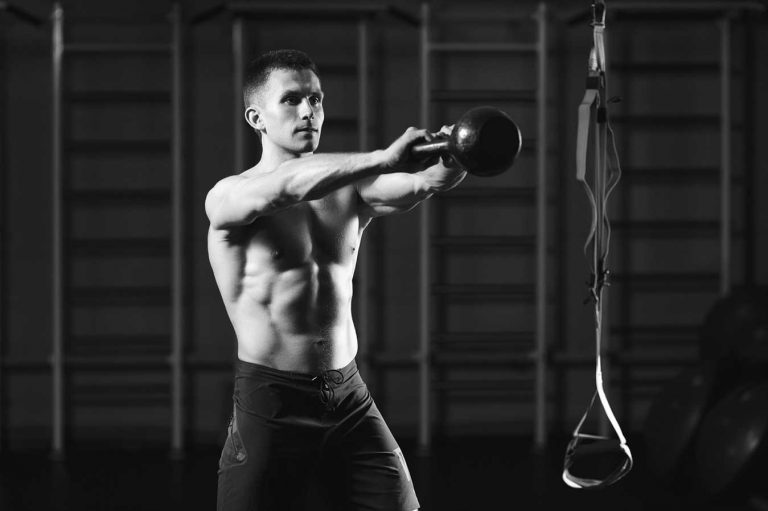I’ve been greatly intrigued by the supposed superiority of e-coat kettlebells vs powder-coated kettlebells for nearly a year. It wasn’t that long ago that powder coating was said to be the cream of the crop for gripping and protection of cast-iron bells. Both types of coating offer excellent resistance to chipping and corrosion. However, proper care and maintenance also play an important factor when it comes to rust. If you regularly forget to wipe the sweat off your kettlebell and/or store it in a moist area rust will appear much more quickly.
So what is all the hype about e-coating anyways? What advantages does it have over powder coating? To answer those questions it’s important to understand both processes. This article does a great job explaining each method of coating. Basically, e-coating is a “wet” process that uses an electrical current for adhesion. The kettlebell is submerged in the epoxy while regulated voltage is applied until desired thickness is reached.
In contrast, powder-coating is considered a “dry” process. Electrically charged particles of the epoxy resin are sprayed directly on the kettlebell. This charge is what makes the resin adhere to the kettlebell. Finally, these particles are cured to produce an attractive matte finish. One of the primary complaints of powder coating is that the thickness level isn’t 100% evenly applied. Although for kettlebells, I think any difference is negligible and the importance of an even coat is only a factor for sensitive industrial products.
Main Differences
The most obvious difference between a powder-coat and e-coat kettlebell is its shine or gloss. According to Rogue’s e-coat specifications the level of shine has a rating of 22 Gloss Units. That’s a huge increase from the 2.5 GU of their powder-coat kettlebell line. Of course, we’re not talking jewelry here so I would expect most people could care less about the difference.
What might be of interest is the type of iron used for the casting. The Rogue Fitness E-Coat Kettlebell is made from ductile iron as opposed to traditional gray iron. As far as durability is concerned ductile iron has more toughness which should increase the lifespan versus powder coat kettlebells made from gray iron. Admittingly, I’m a little skeptical of how practical this feature is for kettlebell exercises and workouts. After all, no one is smashing their kettlebell against the wall or performing similar reckless moves.

E-Coat Kettlebell Features
Working Out With The E-Coat Kettlebell
Since I already owned two 35 lb. kettlebells from Kettlebell Kings, I opted for a lighter weight from Rogue Fitness. My collection is small ranging from 10 to 45 lbs. a piece for weights. For me, I find that 35 lbs. is the perfect weight for regular use when it comes to cardio, strength, and endurance. When I want a faster-paced cardio-style workout is when I opt for my 25 lb. (12 kg.) kettlebell. Therefore, it made sense to choose a 25 lb. e-coat kettlebell to pair with it.
My older 25 lb. kettlebell is a typical cast iron kettlebell produced by Amazon. I know it doesn’t have quite the allure of major name brands but it’s held up just fine. One thing I neglected to consider before purchasing my new 25 lb. e-coat kettlebell was the handle diameter. Thankfully, the circumference of both handles is roughly 12mm and I noticed no functional difference during double-belled workouts. However, I did see another review where the Rogue e-coat kettlebell was paired with an equivalent weight Kettlebell Kings kettlebell. That reviewer did notice a difference in handle size which made it a little awkward for gripping when used together.
If you do plan to use any of these e-coat kettlebells with another brand keep these handle specifications in mind: Handle Diameter: 1.2″ (9LB-18LB), 1.4″ (26LB), 1.5” (35LB-88LB). By my estimations, there is anywhere from 3 to 5 mm difference in handle thickness than the thinner Kettlebell Kings handles. Unless you have smaller handles, I don’t think that should affect you when working out with just one kettlebell at a time.
Texture and Feel
When it comes to texture, the handle of the e-coat kettlebell isn’t as smooth as its powder-coat counterpart. This is no doubt due to the thinner coating. There is a certain grittiness which I think actually helps reduce friction. My hands get very sweaty during workouts and that’s probably a reason why I prefer cast iron over steel competition kettlebells. I seldom use chalk when using my 45 lb. Fitness Edition Kettlebell with its ultra-smooth steel handle. The sweat of my hands combined with the non-porous handle leads to more friction which ends up producing tears and callouses.
It’s a silly comparison but I can’t help but think of hydroplaning when tires with no tread hit water on the road. There’s a definite more slipping-feel with smoother handles which requires a tighter grip. Especially when doing swings, snatches, and cleans. I realize that not everyone has super sweaty hands during workouts or they use chalk to help offset that. Heck, some people even use gloves that have their own pros and cons. However, personally, I just prefer a little textured grip on my kettlebells.
Using a medium or smaller-sized kettlebell shouldn’t matter too much for grip whether it’s powder-coat or e-coat. Both handle surfaces are adequate enough to endure a standard 15 to 30-minute workout without resulting in too much wear on the hands. That is to say if you’re using a weight relative to your comfort level and practicing proper technique. I’d be curious to read what some powerlifters using 53 lb. to 88 lb. kettlebells think about comparing grip.

25 lb. Rogue Fitness E-Coat and 35 lb. Kettlebell Kings Powder-Coat Kettlebells
Why Buy The Rogue Fitness E-Coat Kettlebell?
Obviously, the quality is top-notch. Is it leaps and bounds above other brand-name kettlebells? I would say not. Despite the catchy name, I wouldn’t classify e-coating as revolutionary. As long as the core is cast iron or steel there is no reason a kettlebell shouldn’t last years. Just make sure to stay away from cheap cement-filled, rubber, or other crap material kettlebells. With that being said, here are a couple of reasons to opt for the Rogue Fitness E-Coat Kettlebell.
Price
At the time of this writing, a 35 lb. (16 kg.) e-coat kettlebell costs $55. That’s a great price – half that of a 16 kg. Kettlebell Kings powder-coated kettlebell listed at $109. Ahh, but what about shipping? Kettlebell Kings offers free shipping to the continental U.S., Rogue does not. Although, Rogue does allow you to calculate shipping costs before making a purchase. Plugging in my zip code resulted in a shipping cost of $18.50 and a tax of $4.41 for a grand total of $77.99. That’s more than $30 less than the powder-coat kettlebell from Kettlebell Kings.
Availability
When the COVID-19 pandemic first hit the U.S., there was a huge demand for kettlebells. Because gyms had to shut down people were looking for home fitness solutions to stay in shape. The problem was that supply just couldn’t keep up with the demand. To this day there are still inventory shortages among many brands of kettlebells. It’s especially hard to find common weight kettlebells (12 kg. to 24 kg.).
Kudos to Rogue Fitness for figuring out a solution. There appears to be ample stock of all sizes of e-coat kettlebells in their inventory. So how were they able to do it and others are still struggling? That leads in to my next reason for purchase..
Made in the USA
I was surprised to learn that many kettlebells are manufactured overseas and then shipped back to the U.S. I suppose it was cheaper and more profitable for companies to do so. To their credit, Kettlebell Kings, actually explained to me via e-mail of the difficulty in having kettlebells produced here. You see, to have them made in mass quantity requires the partnership of a foundry. When it comes to U.S. foundries, it just wasn’t worth their time when they can create auto parts and such for large profit margins.
Somehow, Rogue Fitness struck a deal with Michigan-based Cadillac Casting, Inc. that made sense for both parties. The fact these kettlebells aren’t priced astronomically AND are readily available goes to show that Made in America is still viable. I give both companies props for making an excellent product, at a good price that’s readily available.

Rogue Fitness E-Coat Kettlebell Made in Cadillac, MI
Final Thoughts On The E-Coat Kettlebell
As a kettlebell enthusiast for over two years now, they are my favorite piece of workout equipment by far. Great for cardio, strength-building, endurance, mobility, flexibility and so forth, there’s no limit for physical improvement. The e-coat kettlebell won’t make your workout any easier, rather it’s a dependable option that will stand the test of time.
I still very much enjoy using my powder-coated kettlebells and have no plans of removing them from my collection. However, it’s hard for me to justify paying more money in the future when I can still get an exceptional quality kettlebell from Rogue Fitness. Ranging from sizes of 9 lbs. all the way to 88 lbs., their e-coat kettlebell is one that women, men, and youth can use regardless of their skill level.



